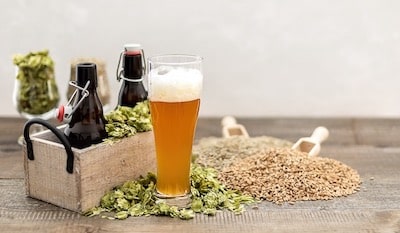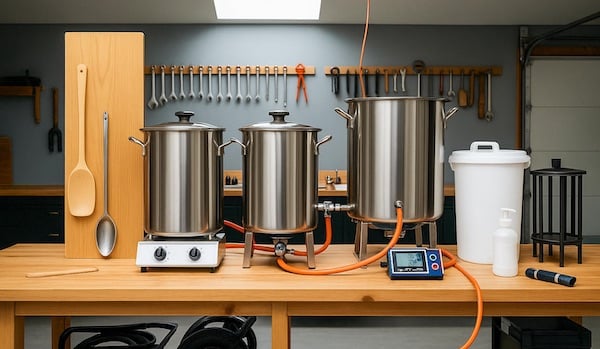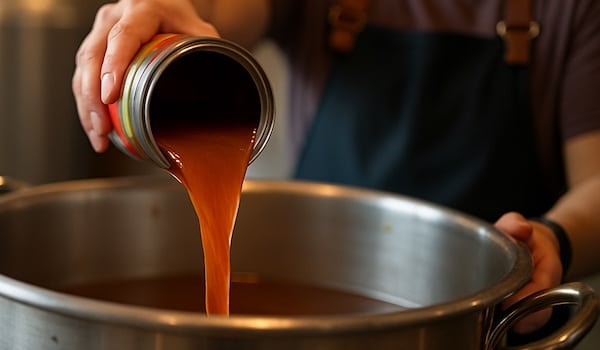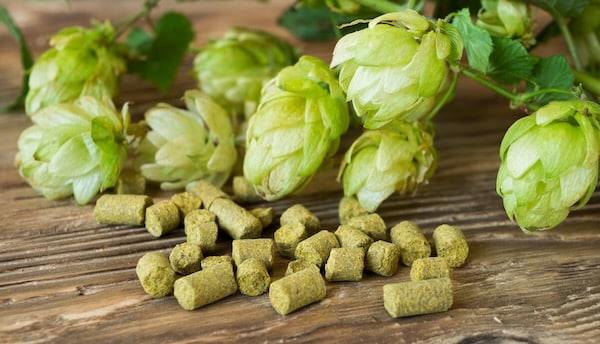
This article may contain affiliate links. If you click them, we may earn a small commission at no extra cost to you.
In This Article
- Introduction
- What Are Hops and Why Do They Matter in Brewing?
- What Are Dried Hops?
- What Are Wet Hops?
- Dried Hops vs. Wet Hops – Key Differences
- Which Is Better: Dried Hops or Wet Hops?
- Can You Use Both Dried and Wet Hops?
- Tips for Homebrewers Experimenting with Hops
- Final Thoughts: Choosing the Right Hops for Your Brew
- Sign Up for Our Newsletter
Introduction
Brewing’s buzziest of all buzzwords (excuse the alliteration) has to be “dry hopped.” You can’t go to a pub or beer store without being bombarded with 50 different varieties of colorfully-labeled IPAs (and now even pilsners) proudly displaying the words “dry-hopped with…”
Dry hopping is a pivotal process for brewing the ever-popular hazy IPAs, but it is also employed to brew a wide range of beer styles. Its wet counterpart is much more elusive as it only happens seasonally. Every autumn during the hop harvest, you’ll start to see “wet hopped” or “fresh hopped” beers pop up on shelves for a limited time.
But what does wet hopping mean? We’ll explore that, and the differences between wet and dry hopping, along with providing a few tips for using these techniques.
Helpful Home Brewing Resources
If you want to level up your home-brewing skills, check out the Craft Beer & Brewing membership. It gives you access to 100+ brewing courses, 400+ videos, step-by-step guides, and downloadable BeerSmith/BeerXML recipe files. You can also explore their full library of online brewing courses here.
👉 Explore the Craft Beer & Brewing membership
What Are Hops and Why Do They Matter in Brewing?
“Hopping” is the brewing process where the flowers of the Humulus lupulus plant are added to beer for flavor, aroma, and bitterness. Originally employed as a preservation method, hopping is now one of the most notable ways for brewers to impart expressive flavors in their beer.
Depending on when and how you add hops during the process, there can be a major impact on the flavors or aromas. Equally important are the specific hops used, as these can produce drastically different results.
RELATED POST:
What Are Dried Hops?
In essence, dry hopping is adding hops later in the brewing process, most often during fermentation or conditioning.
Dried hops are kiln-dried after the harvest in order to preserve them for storage. They’re kept as whole cones or pellet form and are packaged before being sent to brewing suppliers or breweries to be used. Because they have shelf stability, they’re the industry standard for both commercial and homebrewers.
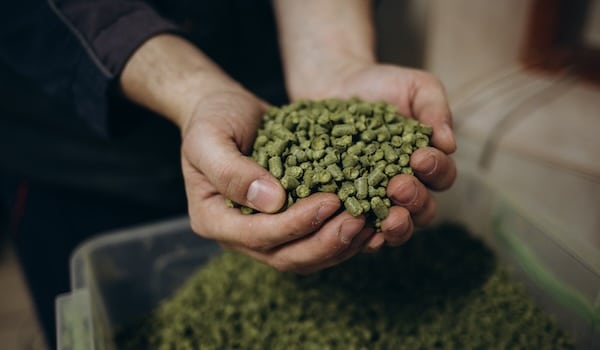
How Dried Hops Are Made
After the harvest, hop flowers are dried for storage. This can be done by air-drying or using methods like a kiln, professional-grade food dehydrators, or dehumidifiers. Once dried, the hops are stored and pelletized.
Pros of Dried Hops
Year-round availability is the primary benefit of dried hops, as the drying process creates shelf stability, consistency, and ease of storage and transport. Dried hops also tend to work in all beer styles, and nearly all brewing practices or education are based on using dried hops.
Cons of Dried Hops
The drying of hops results in the loss of some volatile oils, leading to less “fresh” flavor. Also, pelletization of hop cones, which comes with drying, does change the subtle characteristics.
Popular Beer Styles with Dried Hops
Nearly all beer styles employ some form of dry hopping. IPAs, pale ales, and hazy beers are notable examples where aggressive or “double-dry hopping” is employed.
What Are Wet Hops?
Wet hops, also known as fresh hops, are typically used right after the harvest. This is entirely seasonal as it’s based around when the hop flowers are at peak ripeness.
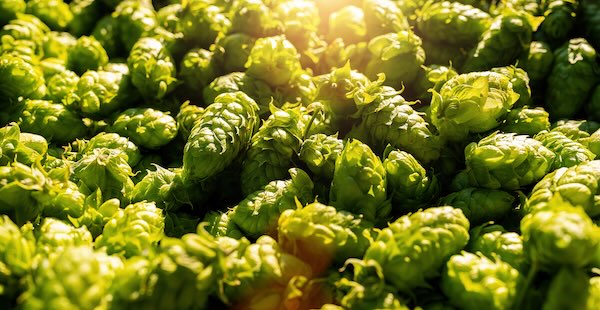
How Wet Hops Are Used
Wet hopping involves adding freshly-picked hops (often within 24 hours of the harvest). These fresh hop additions (usually added in whole-cone form) can be done at any point in the brewing process. Brewers will often visit farms to select their hops, and will have a select batch of fresh hops shipped directly to their brewery for immediate use.
Pros of Wet Hops
The flavor profile of fresh hops is completely unique. You’ll get earthy, grassy, and vegetal flavors that hops lose when dried out. The seasonal appeal and connection to harvest also offer plenty of novelty for drinkers.
Cons of Wet Hops
Fresh hops are highly perishable, making their additions to beer or drying time sensitive. The limited availability and short shelf life are the primary reasons wet hops are a novelty. There are also flavor variability issues, along with substantially higher costs associated with expedited transport.
Popular Beer Styles with Wet Hops
Wet hop IPAs and harvest ales are seasonal, small-batch beers that are favorites for brewers and die-hard beer geeks.
Dried Hops vs. Wet Hops – Key Differences
| Hop Type | Wet Hops | Dried Hops |
|---|---|---|
| Shelf Life | More expensive | Cheaper |
| Flavor and Aroma | More subtle flavors. Earthy and vegetal | Consistent flavor. Can be bold |
| Brewing Process | Needs to be added (often within 24 hours) right after the harvest. Added in whole-cone form at any point in the brewing process. | Can be stored throughout the year. Can be added in pellet or whole-cone form. Hops are added late in the brewing process. |
| Availability | Seasonal | Available year-round |
Which Is Better: Dried Hops or Wet Hops?
When to Choose Dried Hops
These are your “everyday” hops. Not necessarily because they’re better than wet hops, but because they’re consistently available year-round. These are also exceptional for brewing hazy IPAs and incredibly hop-forward beers where you want specific flavors and aromas to be expressed.
When to Choose Wet Hops
Fresh hop beers, which are special seasonal releases and one-of experimental batches, are a brewer’s way to celebrate the harvest. Unfortunately, it’s impossible to brew these beers year-round, so you need to take advantage while the hops are fresh!
Can You Use Both Dried and Wet Hops?
The answer is yes, but only when wet hops are available and advisable to use. If you snag some fresh hops right after the harvest and are ready to brew, you can combine the wet and dry hops and add them, or plan a schedule around it.
It’s most common to add the dried hops during the boil as a bittering agent and then introduce the wet hops for flavor and aroma at the end of the process.
Tips for Homebrewers Experimenting with Hops
For dried hops: Make sure to store your hops in a vacuum-sealed container out of sunlight in a climate-controlled setting.
For wet hops: This can be a difficult undertaking for even professional brewers, so you’ll need to plan carefully if you want to brew a harvest ale at home. If you have access to a local hop farm and can travel back quickly, make sure your hop additions happen as close to the harvest as possible. Add fresh hops at the same schedule as your normal brewing process. You should expect variable results, as these beers are unpredictable.
Final Thoughts: Choosing the Right Hops for Your Brew
If you’re into craft beer, you’re doubtless into hops. There’s a whole world to explore, including hundreds of amazing hop varieties to try in your next homebrew. There’s also a fascinating range of brewing techniques, like wet or dry hopping, that make the brewing experience all the more rewarding!
If you want to build deeper brewing skills, Craft Beer & Brewing’s membership is honestly one of the best brewing education resources online.
🍺 Try It Yourself – Join the Conversation!
Have you brewed with dried hops or wet hops? What are your favorite varieties to either dry or wet hop? Share your experience in the comments!
For more homebrewing (or beer drinking) insights, sign up for our brewing tips newsletter below, or follow us on social media for more recipes and brewing guides.

